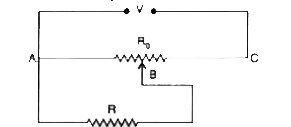An electron, an α−particle, and a proton have the same kinetic energy. Which of these particles has the shortest de Broglie wavelength?Solution in Kannada
For a particle, de-Broglie wave length,λ=h/p
Kinetic energy,K=p2/2m
Then, λ=h√2mK
For the same kinetic energy K, the de-Broglie wave length associated with the particle is inversely proportional to the square root of their masses. A proton (11H) is 1836 times massive than an electron and α-particle (24H) four times that of a proton. Hence, α-particle has the shortest de-Broglie wave length.
λ=hp=hmv
Mass m=hλv
For an electron, mass me=hλeve
=1.813×10−4
Then, mass of the particle m=me(λeλ)(vev)
m=(9.11×1031kg×13×(11.813×10−4)
m=1.675×10−27kg.
Thus, the particle, with this mass could be a proton or a neutron.
Topper's Solved these Questions
- BOOK - OSWAAL PUBLICATIONCHAPTER - DUAL NATURE OF RADIATION AND MATTEREXERCISE - TOPIC-2 DE-BROGLIE RELATION (LONG ANSWER TYPE QUESTIONS)1videos
DUAL NATURE OF RADIATION AND MATTER
- BOOK - OSWAAL PUBLICATIONCHAPTER - CURRENT ELECTRICITY EXERCISE - TOPIC-3 (POTENTIOMETER & APPLICATIONS) (NUMERICAL PROBLEMS)2videos
CURRENT ELECTRICITY
- BOOK - OSWAAL PUBLICATIONCHAPTER - ELECTRIC CHARGES & FIELDSEXERCISE - (TOPIC -2)Numerical Problems5videos
ELECTRIC CHARGES & FIELDS
Similar Questions
What are matter waves? Derive an expression for the de Broglie wave length.
02:30View SolutionA resistance of RΩ draws current from a potentiometer. The potentiometer has a total resistance R0Ω.A voltage V is supplied to the potentiometer. Derive an expression for the voltage across R when the sliding contact is in the middle of the potentiometer.
 03:19View Solution
03:19View SolutionAn atom was earlier assumed to be sphere of radius a having a positively charged point nucleus of charge +Ze at its centre . This nucleus was believed to be surrounded by a uniform desity of negative charge that made the atom neutral as a whole.
Use this theorem to find the electric field of this atom at a distance r(r>a) from the centre of the atom.04:30View SolutionAn electron, an alpha -particle, and a photon have the same kinetic energy. Which of these particles has the shortest, de -broglie wavelenght?
04:27View SolutionAn electron, an alpha -particle and a proton have the same kinetic energy. Which of these particles has the largest de-Broglie wavelength?
02:44View Solutionसामान गतिज ऊर्जा वाले इलेक्ट्रान प्रोटोन तथा α कण में किसकी डी ब्रोग्ली तरंगदैर्ध्य सबसे कम होगी
04:31View SolutionAn electron, an α-particle and a proton have the same kinetic energy. Which of these particles has the shortest de Broglie wavelength?
01:56View Solutionएक इलेक्ट्रॉन, एक α− कण तथा एक प्रोटॉन की गतिज ऊर्जा समान है। इनमे से किस कण का दे ब्रॉग्ली तरंगदैर्घ्य न्यूनतम होगा ?
02:00View Solutionएक इलेक्ट्रॉन, एक अल्फा कण और एक प्रोटॉन की गतिज ऊर्जा एकसमान है। इनमे सेकिस कण का दे ब्रॉग्ली तरंगदैर्घ्य अधिक होगा ?
05:13View SolutionAn electron, an α−particle, and a proton have the same kinetic energy. Which of these particles has the shortest de Broglie wavelength?
View SolutionAn electron, an alpha- particle, and a proton have the same kinetic energy. Which of these particles has the shortest de Broglie wavelength?
03:20View SolutionAn electron, an α−particle, and a proton have the same kinetic energy. Which of these particles has the shortest de Broglie wavelength?
03:09View SolutionAn electron, an alpha-particle and a proton have the same kinetic energy. Which one of these particles has the largest de-Broglie wavelength ?
02:04View SolutionAn electron, an alpha- particle, and a proton have the same kinetic energy. Which of these particles has the shortest de Broglie wavelength?
04:06View SolutionAn electron, an alpha -particle and a proton have the same kinetic energy. Which of these particles has the largest de-Broglie wavelength?
01:02View Solution

